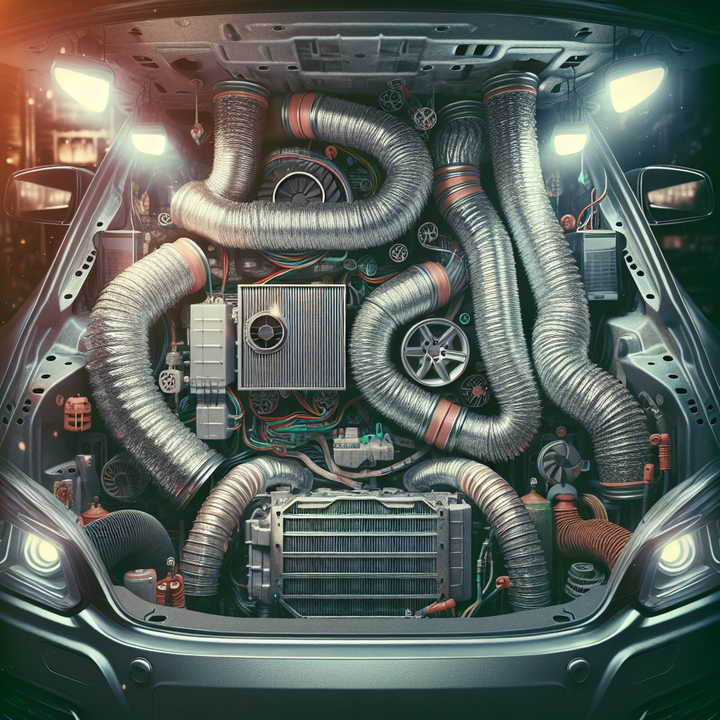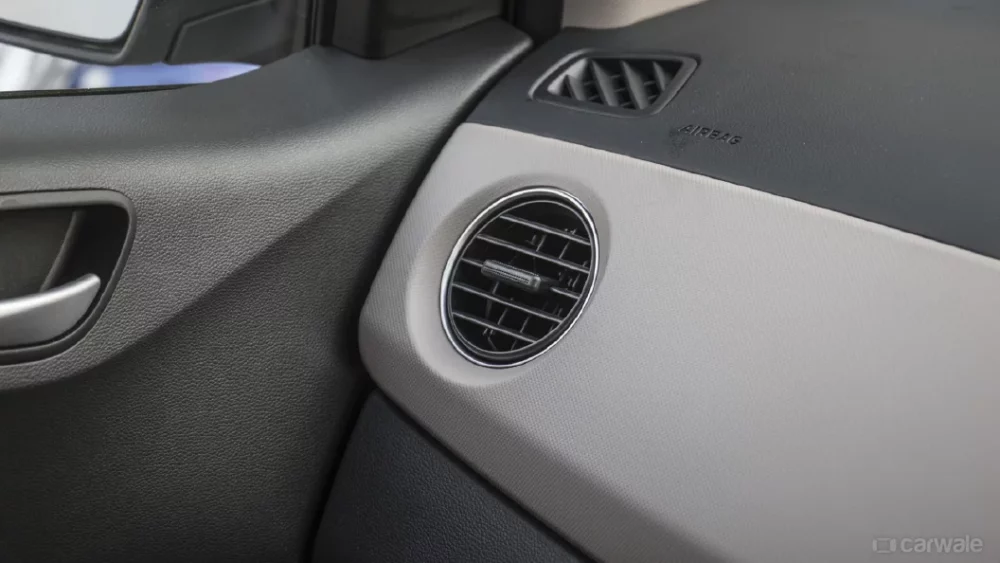


In modern vehicles, the Heating, Ventilation, and Air Conditioning (HVAC) system plays a crucial role in maintaining a comfortable cabin environment. At the core of this system lies a network of air ducts responsible for distributing conditioned air throughout the vehicle. However, over time, these ducts can become damaged or develop leaks, leading to various issues that can compromise the efficiency and performance of the HVAC system. This comprehensive article will explore the causes, signs, and solutions for addressing damaged or leaking air ducts in your car's HVAC system.

Air ducts are an integral component of a car's HVAC system. They form a network of pathways that channel the heated or cooled air from the HVAC unit to the various vents and outlets within the vehicle's cabin. By efficiently circulating conditioned air, they help regulate the temperature and airflow throughout the vehicle's interior. This not only enhances the overall driving experience but also contributes to the well-being and safety of the occupants.
When the ductwork is in good condition, it allows the HVAC system to operate at its optimal capacity, minimizing energy consumption and maximizing cooling or heating performance. Conversely, any leaks or damage can cause the system to work harder, leading to increased energy usage and potential strain on the HVAC components.
Several factors can contribute to the deterioration of air ducts in a car's HVAC system, leading to damage or leaks. Understanding these causes is crucial for addressing the issues effectively.
| Cause | Description |
|---|---|
| Age and Wear and Tear | Over time, the constant exposure to temperature fluctuations, vibrations, and airflow can take a toll on the ductwork. As the vehicle ages, the ducts become more prone to cracks, holes, or disconnections, compromising their integrity. |
| Improper Installation or Maintenance | If the ductwork was not installed correctly during the initial HVAC system setup or a subsequent repair, it can create misalignments, gaps, or improper sealing, resulting in air leaks. Failure to perform regular maintenance and inspections can also contribute to the accelerated degradation of the ductwork. |
| Physical Damage and Rodent Infestation | Accidental impacts or collisions can result in dents, punctures, or other physical damage to the ductwork, compromising its structural integrity. Additionally, rodents or other pests can gnaw through the ductwork, creating holes and allowing air to escape. |
| Corrosion and Moisture Buildup | Metal air ducts are susceptible to corrosion, especially in areas with high humidity or moisture levels. As the metal corrodes, it can weaken the structure of the ducts, leading to leaks or even complete failure over time. |
Identifying the signs of air duct damage or leaks is crucial for addressing the issue promptly and preventing further complications. Early detection is essential for minimizing problems and ensuring a comfortable driving experience.
If certain areas of the cabin feel cooler or warmer than others, it could be a sign of air leaks or blockages in the ductwork. This uneven distribution of conditioned air is often one of the first noticeable symptoms of duct problems.
If the airflow from the vents seems weaker than usual, it may indicate a leak or obstruction in the ductwork. This restricted airflow can lead to inefficient cooling or heating, as the conditioned air is not being properly distributed throughout the cabin.
Strange noises, such as whistling or rattling, coming from the vents or HVAC system can be an indication of air leaks or loose ductwork components. Additionally, if you notice musty or unpleasant odors coming from the vents, it could be due to mold or mildew growth in the leaky ductwork.
If you can visually inspect the ductwork and notice holes, cracks, or other visible damage, it's a clear indication of a leak. Furthermore, if your car's HVAC system is working harder than usual to compensate for air leaks, it can lead to higher energy consumption and increased fuel costs.
To accurately identify and locate any air duct leaks or damage, it's essential to have a professional inspection performed by a certified HVAC technician. Proper diagnosis is crucial for effective repairs.
| Inspection Method | Description |
|---|---|
| Visual Inspection | A thorough visual examination of the ductwork can reveal obvious signs of damage, such as holes, cracks, or disconnections. HVAC technicians are trained to identify visible issues and assess the extent of the damage. |
| Smoke Testing | In this method, a non-toxic smoke is introduced into the ductwork, and any leaks will be visible as the smoke escapes. This technique is particularly effective in locating leaks that may not be visible to the naked eye. |
| Pressure Testing | The HVAC system is pressurized, and any significant drops in pressure can indicate the presence of leaks in the ductwork. This method not only detects leaks but also helps quantify their severity, guiding technicians in making appropriate repair decisions. |
Once the air duct issues have been identified and diagnosed, there are several repair options available, ranging from minor fixes to complete duct replacement. The appropriate repair is essential for restoring the HVAC system's performance.
For small leaks or cracks, technicians may use aluminum tape or mastic sealant to seal the affected areas and prevent further air loss. While this is a cost-effective solution for minor issues, it is often considered a temporary fix and may not address underlying problems.
If specific sections of the ductwork are severely damaged, they can be replaced with new ductwork while leaving the rest of the system intact. This approach minimizes disruption and allows for the preservation of undamaged components, making it a more cost-effective option than a complete replacement.
In cases of extensive damage or leaks throughout the ductwork, a complete replacement of the entire duct system may be necessary to ensure optimal performance and efficiency. While more costly, a full replacement with new ductwork can effectively restore the HVAC system's functionality and prevent future issues.
Regardless of the repair option chosen, it is essential to have the work performed by certified HVAC professionals. Proper installation techniques and adherence to manufacturer guidelines will ensure the integrity of the repaired or replaced ductwork.
Additionally, many HVAC system manufacturers require repairs to be performed by certified technicians to maintain warranty coverage and protect the owner's investment.
While addressing existing air duct issues is important, implementing preventive measures can help minimize the risk of future problems and extend the lifespan of your car's HVAC system. A proactive approach can save time and money in the long run.
Scheduling regular inspections and maintenance checks with a certified HVAC technician can help identify potential issues before they escalate. Early detection and preventive measures can often prevent costly repairs or replacements down the line.
Over time, debris such as dust, dirt, or leaves can accumulate within the ductwork, obstructing airflow and potentially promoting duct damage. Regular cleaning and clearing of debris can help maintain the integrity of the ductwork and ensure optimal airflow.
Properly insulating the ductwork can help prevent condensation buildup, which can lead to corrosion and leaks over time. Adequate insulation also protects the ducts from the effects of extreme temperature fluctuations, reducing the risk of damage.
Rodents or other pests can gnaw through the ductwork, creating holes and allowing air to escape. Addressing any pest infestations promptly and implementing preventive measures can help protect the ductwork from further damage.

Investing in regular maintenance and addressing any air duct issues promptly can provide numerous benefits, both in terms of comfort and cost savings. A proactive approach can maximize the HVAC system's performance.
Properly sealed and maintained ductwork ensures that conditioned air is delivered efficiently, minimizing air loss and reducing energy consumption. This translates to lower energy bills and significant cost savings over time.
Leaky or damaged ducts can allow contaminants, such as dust, mold, or outdoor pollutants, to enter the cabin, compromising the air quality. By addressing duct issues and implementing regular cleaning, you can improve the overall indoor air quality within your vehicle.
By addressing air duct issues promptly and maintaining the ductwork, you can prevent further damage and extend the overall lifespan of your car's HVAC system. This can help you avoid premature system failure and the need for costly replacements.
An efficient and well-maintained HVAC system, including properly functioning air ducts, can help maintain a comfortable cabin environment for both the driver and passengers. This not only enhances the overall driving experience but also contributes to safety by reducing distractions and fatigue caused by extreme temperatures or poor air quality.
Addressing damaged or leaking air ducts in your car's HVAC system is crucial for maintaining optimal performance, efficiency, and comfort. By understanding the causes, recognizing the signs, and implementing appropriate repair and maintenance strategies, you can ensure that your vehicle's HVAC system operates at its best. Regular inspections, prompt repairs, and preventive measures can not only improve indoor air quality and energy efficiency but also extend the lifespan of your HVAC system, ultimately saving you time and money in the long run.
Energy Star estimates that most homes lose 20-30% of heated/cooled air through duct leaks. Properly sealing ducts can significantly reduce this waste.
Duct sealing can reduce energy bills by $100-$500 per year, depending on the home size, existing duct condition, and local energy rates.
The average cost for professional duct sealing is $300-$600 for a typical single-family home, but can vary based on duct accessibility and extent of repairs needed.
While minor duct sealing can be a DIY project using mastic sealant or metal-backed tape, professional duct sealing using aerosol-based sealants is recommended for proper, comprehensive sealing.
Ducts should be inspected for leaks every 3-5 years as part of routine HVAC maintenance to identify and address any new leaks.
Duct leaks can develop from normal aging, rodent/pest damage, poor installation, or impact damage from renovations or storage in attics/crawlspaces.
Yes, leaky return ducts can pull dust, insulation particles, and other contaminants into the air stream, reducing indoor air quality and potentially aggravating respiratory issues.
Yes, even new construction can benefit from duct sealing, as ducts may develop minor leaks during installation or settling of the home over time.
Ductwork may need full replacement if it is very old, has widespread damage, uses outdated materials, or cannot be properly sealed due to inaccessibility.
Proper HVAC maintenance, changing filters regularly, and avoiding storage or activities that may impact ducts can help maintain sealed ductwork condition.

Sarah isn't your average gearhead. With a double major in Mechanical Engineering and Automotive Technology, she dived straight into the world of car repair. After 15 years of turning wrenches at dealerships and independent shops, Sarah joined MICDOT to share her expertise and passion for making cars run like new. Her in-depth knowledge and knack for explaining complex issues in simple terms make her a valuable asset to our team.



